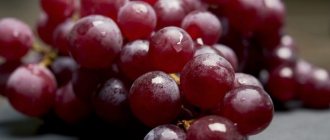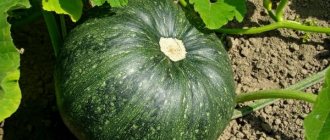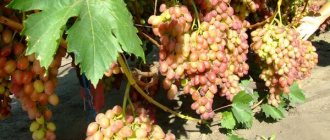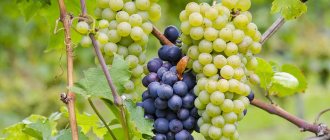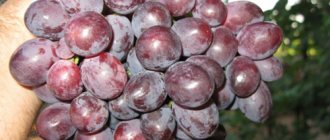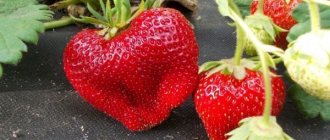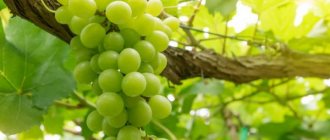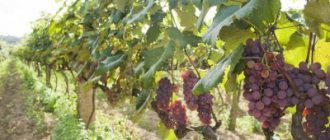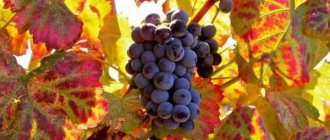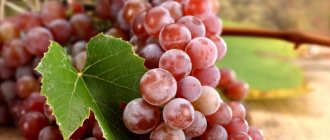History of selection
Svetlana Ivanovna Krasokhina is a researcher at the laboratory of selection and ampelography of the Research Institute of Viticulture and Winemaking named after. Potapenko. She took part in the creation of more than 150 varieties of grapes. The breeder is studying the peculiarities of using growth regulators on table varieties of crops related to the female flowering type. Krasokhina’s research is devoted to the development of new varieties that are resistant to diseases and pests.
Did you know? In Slovenia, in the city of Maribor, there is a vine that is over 400 years old.
It still bears fruit and produces annually from 35 to 55 kg of red Ametovka grapes.
Part of it is used for food, and 25 liters of wine are made from the remaining berries. The article will discuss 8 grape varieties bred by Svetlana Krasokhina.
Krasokhina S. I.
Svetlana Ivanovna Krasokhina belongs to a hereditary dynasty of winegrowers and breeders. Today, there is no grape lover who does not know her father, Ivan Aleksandrovich Kostrykin, because he not only devoted his entire life to breeding new plant varieties, but also became the founder of the domestic school of grape selection. Having absorbed all the love for the vine from her father, Svetlana Ivanovna decided to continue his work.
A PhD diploma opens up a new stage for her in the development of her favorite business, and soon the young scientist produces a huge number of successful grape varieties within the walls of her native All-Russian Research Institute of Viticulture and Winemaking. That’s why soon both amateur gardeners and large production enterprises began to line up for Krasokhina’s grape seedlings.
Today, Svetlana Ivanovna is a Candidate of Sciences, a researcher at the laboratory of selection and ampelography, where she works on developing new varieties of cultivated plants by identifying genetic sources of biologically valuable traits.
Svetlana Ivanovna has become a recognized expert in the field of determining grape varieties and their breeding purity. All this contributed to Krasokhina becoming the main domestic consultant to wineries on the processes of selecting and growing optimal varieties of technical plant varieties.
Descriptions and characteristics of varieties
Depending on the color and scope of the berries, the described grape varieties are divided into several varieties:
- seedless;
- canteens;
- technical.
Seedless
- Kishmish Novocherkassk has an early ripening period - 110 days. The variety was developed through selection of the Villars blanc and Mechta varieties. The bush is small in size, the leaves are round. The fruits are pale pink in color, weighing up to 450 g. The weight of one berry is up to 3 g, round or oval in shape. It is resistant to powdery mildew. The main advantages are the absence of seeds and the rapid survival of seedlings. The disadvantage is the rapid spoilage of fruits on the stems.
- Yasya is a new seedless grape variety that was developed by crossing the Rusvena and Ogonyok varieties. The bush vine is vigorous, the leaves are green. The bunches ripen in 115 days and gain weight up to 1 kg. The weight of one berry is up to 10 g, the color of the peel is purple, the pulp has a pink tint. The advantages of the variety are early ripening and partial immunity to fungal infections. The disadvantage is the tendency for the skin of the berries to crack.
Dining rooms
- Alexa is a variety developed by crossing the varieties Birunitsa and Vostorg. The shoots of the bush are vigorous, the leaf blades are large, have a green tint, and are slightly pubescent below. It is characterized by an average ripening period of 120 to 135 days. The bunches are cylindrical or conical in shape and weighing up to 1 kg. The oval berry weighs 10 g. Advantages include frost resistance and average resistance to fungal diseases. The fruits tolerate transportation well over long distances.
- Zolotinka is an early variety that ripens in 100 days. Bred from the Frumoasa Albe and Korinka Russian varieties. The bush is highly climbing, the leaf blades are small and rounded. The clusters are wide, conical in shape, weighing up to 800 g. The berries are greenish in color and weighing up to 10 g. Resistant to gray rot and mildew. The disadvantage is the lack of immunity to oidium disease.
- The Baklanovsky grape was developed by crossing the Original and Vostorg varieties. It is characterized by early ripening at 110 days. The clusters have a conical shape and reach a weight of 900 g. Round white berries weigh about 7 g. Resistance to putrefactive diseases is high, frost resistance is average. Over the years, there has been a decrease in yield, which is a disadvantage of the variety.
- Kesha muscat grapes are bred from the varieties Vostorg and Frumoasa Albe. It has an average ripening period of up to 130 days. Wide conical clusters weigh up to 1200 g. The berries are white, round, weighing up to 12 g. The variety is frost-resistant and partially resistant to fungal infections. Disadvantage - abundant yield leads to breaking off the stems.
Technical
- The Platonovsky grape variety was bred by crossing the Zaladende and Podarok Magaracha varieties. Ripening time is 115 days. The fruit clusters have the shape of a cylinder, pointed towards the bottom, and weigh 300 g. The berries are medium-sized, round, white, weighing about 2 g, and have a pleasant nutmeg aroma. The taste is sweet. It has a lot of advantages, which include frost resistance (down to –29°C), resistance to putrefactive and fungal infections.
- Muscat Pridonsky is another representative of technical varieties, bred by crossing the Druzhba and Oreon varieties. Ripening time is average - up to 130 days. The bushes are developed and are characterized by strong ripening of the vines. The clusters are cylindrical, weighing up to 350 g. The berries are spherical or oval, weighing up to 3 g, white or pink. The thin-skinned berries have juicy pulp and a nutmeg aroma. The advantages of the variety include frost resistance, as well as average resistance to gray rot and phylloxera.
Popular varieties
When it comes to Svetlana Ivanovna Krasokhina, most gardeners have an association with elite grapes and characteristic varieties. These primarily include table and technical winter-hardy species with increased yield, low number of seeds and a light but expressive nutmeg aroma. The fruits of such plants have a pleasant, delicate taste and improved technical characteristics for the production of alcoholic and non-alcoholic drinks.
Seedless
Seedless varieties are one of the most popular among our compatriots, as they have a pleasant nutmeg taste, are juicy and almost completely seedless. This characteristic became one of the main reasons that provided seedless species with nationwide popularity both among the common population and among huge industrial holdings.
Related article: Simone - grapes
Among Krasokhina’s works, the most popular varieties are:
- "Assol" : grapes that have an average ripening period (about 130 days). In temperate climates, the berries ripen in the first half of September. The bushes are not large in size. The clusters are large, weighing up to 700 g, the berries are small. The weight of the average berry is about 3 g; they belong to the 2nd class of seedlessness. The shape of the berries is slightly oblong, there is a point at the top, the color is in most cases bright pink. The taste is pleasant and complete. The pulp is juicy. Fruitful shoots on the bush are no more than 60%. The variety is resistant to downy mildew;
- "Kishmish Novocherkassk" : a plant of medium or late maturation. The optimal time for obtaining the first harvests in the temperate climate zone is early September. The clusters are not large in size, weighing about 400 g. The berries are medium in size and belong to the 4th class of seedlessness. The weight of the average berry is within 3 g, and their shape is oval, sometimes ovoid. The color of the fruit is within pink shades. The pulp is fleshy and juicy, the taste is holistic, the number of fruitful shoots varies between 70-90%. The variety is resistant to gray rot and downy mildew;
- "Yasya" : one of the newest varieties, the berries ripen early, no later than the end of July. The clusters are large, their weight is within 600 g, and in some cases up to 1 kg. The berries are large, the weight of 1 berry is in the range of 5-6 g, oval in shape, purple shades predominate in color. The pulp is juicy, fleshy, with a consistent nutmeg flavor. The grapes belong to class 1-2 of seedlessness. The number of fruitful shoots is within 70-80%. The variety is resistant to mycoses of various origins.
Dining rooms
The next most common type of “Krasokhinsky” grapes are table varieties. Despite their youth, they actively conquered household plots and also became an indistinguishable part of the counters of many stores.
The most popular of them are:
- "Alexa" : a variety that ripens early (no more than 120 days). The bushes are large, the clusters are large, reaching a mass of about 1 kg. The berries are white and quite large in size, which is very noticeable compared to other varieties, oval in shape. Their average weight is within 14 g. The pulp is dense, juicy and meaty. The taste is pleasant. The number of fruiting shoots does not exceed 60% of the total mass. The variety is not damaged by wasps and shows noticeable resistance to the pathogens of gray rot, powdery mildew and downy mildew;
- “Talisman”: the fruits of the plant ripen early (no more than 130 days). The bunches are small, but reach an average weight of 800-1100 g. The berries are very large, which is noticeable to the naked eye: the average weight of one berry is in the range of 11-15 g. With proper care, the berries are light in color (mostly white). The taste is holistic; when fully ripe, a light muscat tint is added to the overall taste. The number of fruitful shoots is approaching the maximum level and is about 70-90%. Resistance to downy mildew and gray rot - increased;
- “Zolotinka” (Galbena Nou): an early variety of moderate latitude, which ripens in 110-120 days. The bushes are tall. The grape bunches are large, but their weight does not exceed 700 g. The berries are large, their average weight is no more than 8 g. They are rounded or oval in shape, and the color variety of the berries ranges from soft green shades. The fruitfulness of shoots does not exceed 80%. “Zolotinka” is resistant to gray rot and downy mildew.
Technical
Krasokhina's technical grape varieties occupy more than one catalogue, but only a few remain the most popular. They managed to win over the manufacturer primarily with high yields and improved technological characteristics relative to their competitors. Among them it is worth noting:
- "Platovsky" : very early grapes, its ripening period lasts no more than 115 days. The clusters are medium in size, and their weight does not exceed 200 g. The berries are small, round, their weight is no more than 2 g. The color of the berries is predominantly white, but in the sun a characteristic pinkish tint appears. The pulp is juicy, the outer integument of the berry is distinguished by a thin but durable skin. The taste is pleasant and uniform. The number of fruitful shoots reaches 85%. The variety is resistant to severe frosts (up to -29° C), as well as to gray rot, downy and powdery mildew, and phylloxera;
Basic rules for planting and further care
In order for the grapes to take root and develop well, it is necessary to choose the right planting site. The plant must be planted in a place with low water levels, the permissible norm is 1.5 m, otherwise the rhizome will rot and interfere with the development of the crop.
Planting is done on crushed stone or rocky soils. The soil should be slightly acidic. Seedlings are planted only in heated soil, when the air temperature is consistently high - +20°C. Planting is usually carried out at the end of May.
Important! When purchasing a seedling, you must carefully inspect the plant for diaper rash, rotting and damage to the root system. To be sure of the authenticity of the planted variety, it is better to purchase a seedling in a specialized store.
Preparing the planting hole and soil:
- Dig a hole measuring 70x70 wide and 80 cm deep.
- Pour crushed stone into a 10 cm layer at the bottom of the hole for drainage.
- Prepare a substrate from the top fertile layer of soil mixed with 20 kg of humus and 10 kg of sand.
Immediately before planting, the seedling is placed in a solution for rapid growth of the rhizome. You can use the drug “Kornevin” at the rate of 30 g per 1 liter of water. The residence time of the seedling in the solution should be at least 3 hours.
Planting a seedling:
- Fill the prepared hole with soil up to the middle, forming a small hill.
- Carefully place the seedling in the hole and level the root system along the embankment.
- Fill the top of the hole with substrate so that the seedling looks 3-4 cm above the ground.
- Compact the soil with light pats.
- Water the seedling with 5 liters of warm water at a temperature of +20°C.
- After this, cover the soil with a 10 cm layer of sand.
Caring for grapes begins in March, when it is necessary to carry out the pruning procedure. This must be done before the buds begin to swell, otherwise juice will leak from the cuts and there will be a risk of fungal infection. In the spring, the first preventive irrigation is carried out against infections and pests. The procedure is carried out at a temperature from +4°C to +6°C; a 3% solution of copper sulfate is prepared for it - 300 g per 10 liters of water.
Did you know? To make 1 bottle of wine, 6 kg of grapes are required.
The second preventive procedure is carried out in mid-summer, the plant is treated with the drug “Quadris” (60 ml per 10 l of water), and fertilizing is also applied in the form of the drug “Aquarin” (25 g per 10 l of water). At the end of August, phosphorus-potassium fertilizer is applied at the rate of 15 g per 10 liters of water. Starting in April, it is necessary to tie up the regrown vines. At the same time, stepchildren and weakened shoots should be removed. Watering is carried out 2 times a month as needed. It is necessary to add up to 20 liters of water to each bush.
Varieties bred by a breeder
Several forms that were bred by S.I. Krasokhina attract special attention and enjoy well-deserved success among winegrowers.
Grapes "Platovsky"
A technical variety from the parent line, represented by the varieties “Zaladende” and “Magarach’s Gift”. Known to many as “Early Dawn”. The ripening period is 110 or 115 days.
The bushes are characterized by average growth vigor. The grape clusters have a cylindrical conical shape and are of medium size, weighing no more than 250 g. The berries are round in shape and medium in size, weighing about 2 g. The main color of the berries is white. The taste is good. The taste of the grapes is very harmonious, and the pulp is characterized by juiciness.
The plant is distinguished by shoot ripening at 80% and can easily withstand a load of 80 buds. Pruning should be done with 3-4 eyes. Frost resistance down to -29°C. Resistance to major fungal infections and rot is sufficient. The variety is characterized as ideal for making high-quality wine.
Related article: Grape ash
Grapes "Muscat Pridonsky"
A variety obtained by crossing the varieties “Orion” and “Druzhba”. These are white wine grapes of medium late ripening. Harvest begins after 130 days.
The bushes have fairly strong growth and good vine ripening rates. The bunch of grapes has a cylindrical conical shape, average size and average density, weight varies from 200 to 250 g.
The berries have an average weight of 2.5 g, a round or slightly oval shape, and a characteristic white color. The taste is harmonious, there is a nutmeg aroma. The pulp is very juicy, covered with a thin but durable skin. Sugar accumulation indicators do not exceed 20.0 g/100 cm 3, acidity is 12.0 g/dm 3. The number of fruitful shoots is about 95%, the fruiting coefficient ranges from 1.6 to 1.8.
The bush can easily withstand a load of 60 buds. Pruning is carried out with 3 or 4 eyes. The plant can withstand frosts down to -27°C. The grapes demonstrate average resistance to mildew, oidium, gray rot and phylloxera. Ideal for making high-quality wines, the drinks receive high ratings during tasting.
Grapes "Baklanovsky"
A table variety obtained as a result of crossing the “Original” and “Delight” grapes. Also known as “Oval Delight” or “Original Delight”.
Full maturation occurs on the 115-125th day from the moment the buds awaken. The bushes are characterized by medium growth vigor and form large, moderately dense conical-shaped brushes weighing from 600 to 900 g. The berries are large in size, white in color and have a round, even shape.
The taste characteristics are good. The taste of the juicy pulp of ripe berries is very harmonious. The variety is distinguished by excellent shoot ripening, which reaches 80%. The standard load is no more than 40 eyes. It is recommended to prune with 8-10 eyes. The plant can withstand frosts down to -25°C. It is highly resistant to rot.
Grapes "Talisman"
Table grape variety from the parent line represented by the varieties “Frumoasa Albe” and “Vostorg”. Also known as “Super Kesha” and “Kesha Nutmeg”.
The average ripening period can vary depending on weather conditions from 120 to 135 days. The flowering type is functionally female with good pollination rates. The bunch of grapes is formed wide, conical and quite large. Average weight varies from 800 g to 1.1 kg. The bunches are characterized by medium density. The berries are white, most often large, with an average weight of 12 to 16 g.
The taste is good. The taste is quite harmonious, with the presence of a subtle nutmeg. The juicy pulp is covered with a completely edible skin. Vine ripening rates reach 90%. Frost resistance of the variety down to -25°C. There is sufficient resistance to major grape diseases and rots.
Grapes "Alexa"
A table variety of white grapes obtained from the parent line, which is represented by the varieties “Birunitsa” and “Vostorg”. From the moment the buds awaken on the vine to the harvesting phase of the fully ripened harvest, 120 to 130 days pass. The grape bushes of this variety are characterized by strong growth and bisexual flowering.
Grape clusters are cylindrical-conical in shape, large in size, weighing from 650 g to 1 kg or more. The bunch has a moderately dense structure. The berries are large in size, oval in shape, with white skin. The weight of the berries varies from 10 to 14 g.
The taste is decent. The taste is very harmonious, the flesh is juicy. Shoot ripening rates reach 60%. The standard load on a bush is no more than 40 eyes. Pruning should be done with 6-8 eyes. Frost resistance down to -25°C. Resistance to major grape diseases and rots is average.
Grapes "Zolotinka"
The variety transferred to the State Survey under this name is better known as “Galbena nou” or “New Yellow”. Obtained as a result of crossing varieties of the parent line “Frumoasa albe” and “Korinka Russian”.
From the moment the buds awaken until the berries fully ripen, it takes from 105 to 120 days. Grape bushes are characterized by strong growth and are capable of forming wide-conical, fairly massive clusters. The weight of a grape bunch can vary from 400 to 850 g. Ripe bunches have moderate looseness.
The berries are large in size, white with an amber tint and round in shape. The taste is high. The taste is harmonious, with slight notes of nutmeg. The pulp is quite dense and juicy. Shoot ripening rates are 80%.
Features of the use of grapes
Grapes are widely used in the food industry.
In particular, it is used to make:
- juice;
- jam;
- raisin;
- wine;
- essential oil.
Due to the high content of ascorbic acid, riboflavin and carotene, these berries are useful for anemia, colds, and heart muscle dysfunction.
You will be interested to read about the beneficial and harmful properties of black and white grapes.
With daily consumption of grapes, a general strengthening effect occurs on all body systems, namely:
- heart rate normalizes;
- shortness of breath goes away;
- blood pressure decreases;
- insomnia goes away;
- emotional state improves.
So, Krasokhina’s grape varieties are unique plant specimens that are distinguished by high yields and immunity to many diseases. Berries have a wide range of uses and are an important component of the human diet.
About the work of winegrower S. I. Krasokhina
Svetlana Ivanovna is an outstanding successor to the dynasty of winegrowers, through whose efforts more than 150 varieties of this crop were produced. Krasokhina is studying the peculiarities of using growth regulators for table grape varieties that have a female flowering type.
S.I. Krasokhina has already become the owner of four copyright certificates for grape varieties and two patents for inventions. In addition to research devoted to improving the varieties bred by breeders and developing new hybrid forms with improved resistance to damaging factors, Svetlana Ivanovna advises winegrowers on the choice of varieties and the necessary agricultural technology.
Reviews from winegrowers
Both experienced and novice winegrowers are very familiar with the hybrid forms that were selected by S.I. Krasokhina. Both self-rooted and grafted seedlings have good vitality and adapt fairly quickly. Experienced gardeners recommend taking into account one of the main rules for choosing grapes for cultivation: you need to make sure that the hybrid form is zoned.
The varieties bred by S. I. Krasokhina have earned the following reviews from winegrowers:
- “Platovsky” is characterized as very successful for producing homemade wine. However, it is noted that wine from these grapes is susceptible to oxidation under the influence of oxygen, so you should definitely use potassium pyrosulfate or fumigate the must with sulfur.
- The scourge of a significant part of the vineyards - the destructive disease phylloxera - is not terrible for Muscat Pridonsky , which makes this hybrid grape form very popular among many winegrowers involved in growing berries for sale.
- “Baklanovsky” form has a fairly high resistance to mildew and oidium, and is also slightly affected by gray rot. To many amateur gardeners, the taste of this variety seems rustic, devoid of sophistication. However, the survival rate of cuttings and productivity have earned the most flattering reviews.
- The hybrid form “Talisman”, with proper care, can generously provide the winegrower with very tasty berries, which are suitable not only for personal use, but also for sale.
- The new and very promising table grape “Alexa” , in the opinion of most gardeners who cultivate different varieties, is truly worthy and is distinguished by the fact that it bears fruit abundantly and forms a marketable harvest, regardless of weather conditions.
- The grapes called “Zolotinka” enter the fruiting phase in the 2nd or 3rd year after planting the seedlings. Further productivity and quality of berries depend entirely on compliance with agricultural technology.
